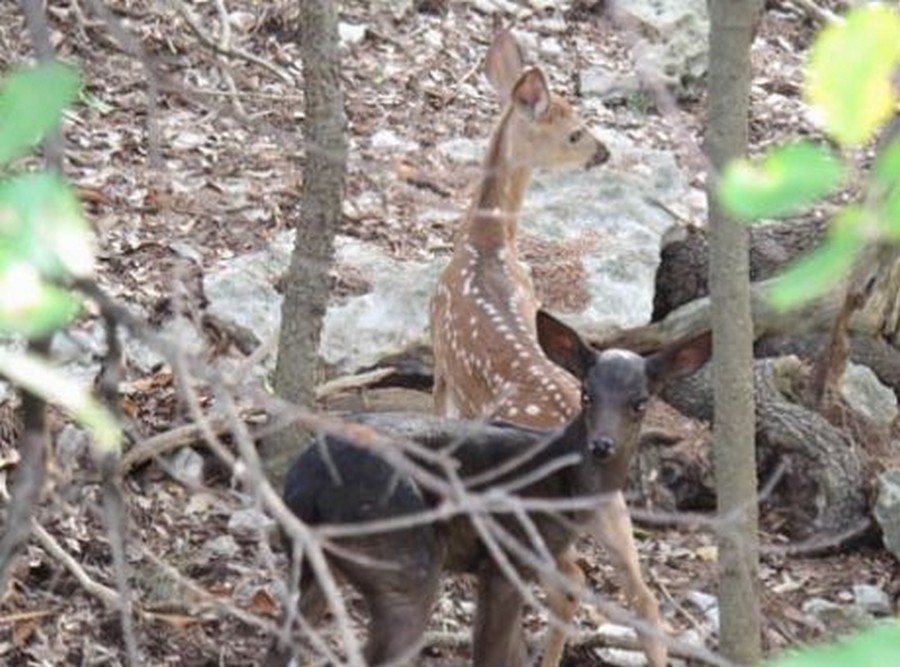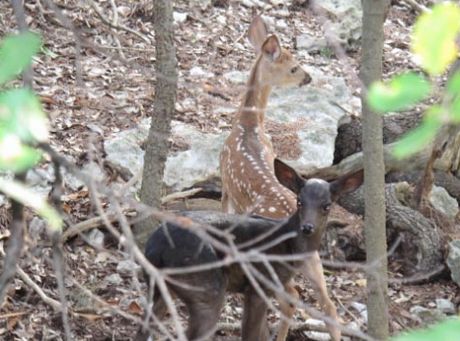Most people, including me, find any variation in white-tailed deer quite intriguing. In fact, most hunters and deer managers even select for certain characteristics, specifically when in comes to antler configuration. Depending on the individual hunter, they may look to harvest bucks with really wide antler spreads, bucks with numerous points, bucks with non-typical antlers, or very old deer. Color is also selected for by hunters because if the opportunity presents itself, many hunters will not hesitate to harvest a uniquely-colored deer. However, I do not know of any individual or ranch that manages for deer color.
Although there is some amount of color variation between all living whitetail, we all know what a white-tailed deer should look like. They are usually some variation of brown on top with white under the body, on the throat-patch, around the eyes and nose, and let’s not forget the white under the tail. After all, they are white-tailed. We know how a deer should look, but this is exactly why any color variation, even minor, sticks out. We, as predators, pick up on any abnormality or weakness exhibited by deer. This is why we do not see many white albino deer or black melanistic deer–they occur rarely, and when they do, these deer are removed from the population by hunters or natural predators. That is unless these deer are found in protected areas, such as urban or suburban areas.
Such is the case with the city of Austin, Texas. Melanistic deer naturally occur in this area and show up again year after year. Black-colored deer occur throughout the United States in very small numbers, but apparently the gene pool for melanistic deer is well-stocked in Austin. From a genetic standpoint, this makes sense. The “normal” color observed in deer is the result of dominant genes. Any variation in that color is caused by abnormal, or recessive genes. Just as many deer management programs spare certain bucks to concentrate genes for specific traits, the melanistic deer in Austin, Texas, have been spared because they live in a developed area.
This has allowed the very recessive genes for black hair, at least in white-tailed deer, to be passed on in a “protected” area with little to no predators. And although these genes are concentrated, the genes are recessive and do exist in an open population. So not every deer is melanistic, but melanistic deer can occur when melanistic deer, or deer that carry melanstic genes (but look normal), breed. The take home message as it relates to deer management on your property is that certain genes–even rare ones–can be increased within a population if managed and protected.






I have never seen this black color of deer in all my years… thanks for sharing!
Yea,h I can see why someone would have a heart attack over that monster deer. I have seen some nice deer in my time of hunting, but nothing close to that big. He is definitely a nice looking deer.
We have a pair of fawns, one is a standard whitetail fawn and the other is black. We see them in our backyard. The mother appears to be a standard whitetail doe. We have several adult black deer and some that appear to have traits of both in our country neighborhood [everyone has 2 – 10 acres] outside of Dripping Springs.
The advantage to the black deer is that they disappear in shadows. You can’t see them under a large cedar. Very interesting, but we notice that their heads are skinnier and ears are bigger. It’s not just a color variation.
Was out running this morning and saw a melanistic doe in a neighbor’s yard. We live out past Lago Vista, Texas, where there are probably more deer than people, so I was really intrigued by the little doe I saw today. She was more delicate-looking than the other white tails in our neighborhood.
We have 3 small fawns in our neighborhood. At first they were with mamma. Now we just see the 3 little ones. They still have the white spots on their backs. We were wondering if the doe has weaned them or if something has happened to her. What is the age of fawns being weaned? Thanks for your help.